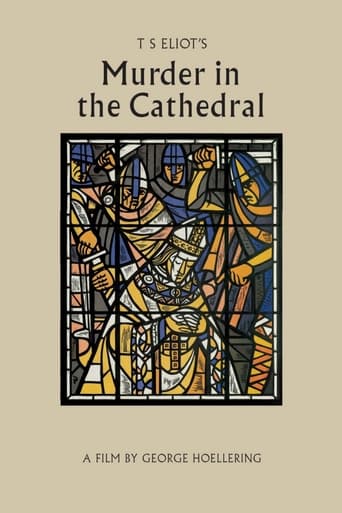Dr Jacques COULARDEAU
This concerns the only public artifact connected to the film, the book entitled "The film Murder in the Cathedral" The film itself, by T.S. Eliot and Hoellering is not available. A copy exists in the archives of the British Film Institute but it does not seem easy to get to it. What a shame for a cult play like « Murder in the Cathedral » ! The book presents the complete scenario with of course the text and all the directions necessary to imagine what is happening on the screen. Plus a great number of illustrations taken from the film, which gives us a sample of the atmosphere on the screen. And that makes this book really beautiful, like an art book of kinds. But we are altogether reduced to analyzing the script and comparing it with the play itself. A short introduction (in the film of course) is added to explain the audience the political situation at the moment when Thomas Becket comes back to Canterbury after a seven years' exile. Then there will be little change in the text till the end and the come-back of the knights after the killing. In fact in the film they don't come back but are confronted to a hostile crowd arriving in the cathedral. They have to explain themselves to save their skin. These explanations are a lot shorter and situationally directed at the crowd. Yet at the very end the tone will change with the changing of the target which becomes the audience today, eight hundred years after the event, which was the original target and tone in the play. The shortening of this section does not take too much out because in fact this section in the play is kind of a play in the play and has no dramatic justification on the stage. The purpose of this scene seems to be in the play the desire to name the four knights and the desire to alleviate their crime by a sound historical explanation that heavily burdens Thomas Becket with unsound political and religious judgment. Just after that the intervention of the priests is cut off and we get directly to the concluding Chorus. The most significant changes come in the various choruses. I will quote the chorus after the intervention of the four tempters. A first chorus is attributed to a priest in the film and then the chorus of the four tempters is split among these and that changes the meaning of the fourth tempter who is no longer a tempter but becomes very precisely the guardian angel Thomas Becket refers to at this moment, and clearly this guardian angel has advised Thomas Becket to keep along an unyielding line and hence to become a martyr. So, Becket's refusal when that tempter was tempting him is only cosmetic. Clearly then his attitude will be to provoke violence and be submissive to it. It sure is self-murder (to use the word in the German operatic adaptation), or plainly suicide. But we will note that the film makes the identity of this fourth tempter very clear and yet it cuts off the reference to « suicide while of unsound mind » that is contained in the play in the mouth of one of the knights. This splitting of choruses into their members enables the film to clearly demonstrate the existence of four knights, which is not at all clear in the play where you often have only three knights speaking together. In the film, systematically, the four are stated as speaking one after another or together. The splitting of the women's chorus after the first discussion between Thomas Becket and the knights is interesting because of the numerical symbolism we should analyze in depth in the whole play, or film. 1st woman – 2nd w. – Chorus (prose) – 3rd w. – 4th w. – 5th w. – 6th w. – 7th w. – 8th w. – 3rd w. – 9th w. – 10th w. – Chorus (8 lines) – 4th w. – 11th w. – Chorus (6 lines) – 10th w. – Chorus (prose). Without entering more details here (every single one of the numbers used to list the women is meaningful in Christian symbology, both in number and rank), it seems very clear that such elements reinforce greatly what we can find in a few strategic places in the play, such has the final quatrain : the crossing of three symbolism (at least), viz. Solomon's number or David's star (3 + 3 = 6), the trinity in all its values (christian, but also the basic disruptive element in the English tradition going back to the Elizabethans and the iambic pattern of English poetry), but also the simple, neutral, balanced binary element that gets into various associations and various values : 2 + 2 = 4 and Christ in his Passion and on his cross, hence the martyr ; 2 + 2 + 2 = 6 and we are back to Solomon's number, but seen from a binary standpoint ; 2 + 2 + 2 + 2 = 8 and the Christ in his glory of the Resurrection and the Second Coming, hence the martyr in glory after his death, and seven, here and there, as the holy week, the week of the passion, and once again the reference to martyrdom as suffering and glory at the same time since the glory comes within the suffering and from the suffering. When we see how the text of the film has been reworked upon to increase these symbolical elements we regret even more than before the absence of the film itself.Dr Jacques COULARDEAU, University of Paris Dauphine & University of Paris 1 Pantheon Sorbonne


